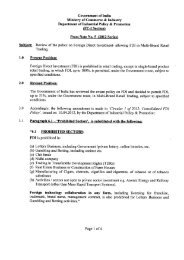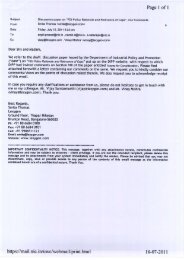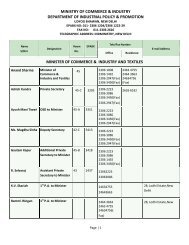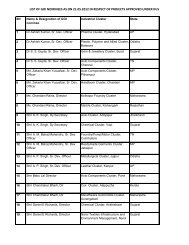fdi in india and its growth linkages - Department Of Industrial Policy ...
fdi in india and its growth linkages - Department Of Industrial Policy ...
fdi in india and its growth linkages - Department Of Industrial Policy ...
Create successful ePaper yourself
Turn your PDF publications into a flip-book with our unique Google optimized e-Paper software.
FDI IN INDIA AND ITS GROWTH LINKAGES<br />
companies <strong>in</strong> that sector. By this method, the entire sample of 2,000 companies was allocated <strong>and</strong> then redistributed<br />
across sectors. This sample accounted for 39 per cent of total cumulative FDI.<br />
After the allocation of samples to the sectors, the next stage of sampl<strong>in</strong>g <strong>in</strong>volved exact identification of companies<br />
through the simple r<strong>and</strong>om selection method. This was achieved by the use of SPSS software through which the<br />
allocated companies <strong>in</strong> each stratum were r<strong>and</strong>omly selected without replacement. 2 This formed the total sample of<br />
companies to which questionnaires were to be sent.<br />
Efforts were made to compile company addresses s<strong>in</strong>ce the DIPP records conta<strong>in</strong>ed only the company names <strong>and</strong> not<br />
their addresses. Different sources, such as the Capital<strong>in</strong>e <strong>and</strong> Prowess databases <strong>and</strong> various websites, were used to locate<br />
these addresses.<br />
After compil<strong>in</strong>g the addresses of both manufactur<strong>in</strong>g <strong>and</strong> services firms, we posted the questionnaires to companies<br />
across India. About 1,500 questionnaires were despatched along with cover<strong>in</strong>g letters from DIPP <strong>and</strong> NCAER. After<br />
three months of wait<strong>in</strong>g <strong>and</strong> a follow-up, we received very few responses, so the survey was conducted through<br />
personal <strong>in</strong>terviews.<br />
7.2 Difficulties <strong>in</strong> Conduct<strong>in</strong>g the Survey<br />
The first problem was collect<strong>in</strong>g the addresses of the manufactur<strong>in</strong>g <strong>and</strong> service firms, <strong>and</strong> several sources were used<br />
to locate them. Most of the <strong>in</strong>formation compiled from the M<strong>in</strong>istry of Corporate Affairs website <strong>and</strong> the <strong>in</strong>ternet<br />
was outdated as many companies had either shut down or relocated. We ma<strong>in</strong>ly relied on the <strong>in</strong>formation <strong>in</strong> the<br />
Capital<strong>in</strong>e database.<br />
Other difficulties were as follows: lack of responses from company representatives, <strong>in</strong>clud<strong>in</strong>g the top management; most<br />
respondents merely h<strong>and</strong>ed over annual reports of the company <strong>and</strong> were not will<strong>in</strong>g to discuss the questionnaire; <strong>and</strong><br />
those who did discuss the questionnaires could not answer many of the questions due to lack of <strong>in</strong>formation. Thus, the<br />
response rate to the questionnaires was low.<br />
We received more than 400 responses but selected only 284 due to data consistency. These <strong>in</strong>cluded 129 manufactur<strong>in</strong>g<br />
firms <strong>and</strong> 155 service firms.<br />
7.3 Analysis<br />
All the completed questionnaires were entered <strong>in</strong> an Excel database <strong>and</strong> SPSS software was used to tabulate the<br />
aggregated results. All <strong>in</strong>dividual company data rema<strong>in</strong> confidential.<br />
<strong>Of</strong> the 284 FDI-enabled firms, there are 129 manufactur<strong>in</strong>g firms (25 are common with the secondary data base) <strong>and</strong><br />
155 service companies (9 are common with the secondary data base) (Table 7.1a). These companies are spread across<br />
four zones – East, North, South <strong>and</strong> West – <strong>and</strong> also large <strong>and</strong> small cities, where large cities comprise Class-1 <strong>and</strong><br />
Class-2 cities comb<strong>in</strong>ed, <strong>and</strong> small cities are Class-3 cities. The large cities are towns with a population of 5,00,000 <strong>and</strong><br />
above, <strong>and</strong> Class-3 cities are towns with a population of less than 5,00,000. This bifurcation of large cities <strong>and</strong> small<br />
cities was made partially to address the question of where FDI goes with<strong>in</strong> a particular zone. More specifically, the<br />
<strong>in</strong>terest was <strong>in</strong> know<strong>in</strong>g whether FDI is concentrated <strong>in</strong> large cities, i.e., metros, or small cities/towns/rural areas. <strong>Of</strong> the<br />
284 firms which could be surveyed, there is concentration of firms <strong>in</strong> the North <strong>and</strong> South zones followed by the West<br />
zone; there are few FDI-enabled firms <strong>in</strong> the East zone. The maximum number of surveyed manufactur<strong>in</strong>g firms is <strong>in</strong><br />
2. The number of companies r<strong>and</strong>omly selected from each stratum was different depend<strong>in</strong>g on their weightage.<br />
74












